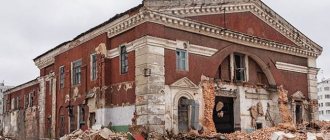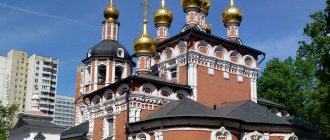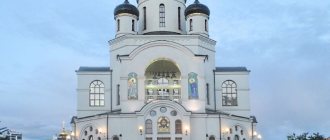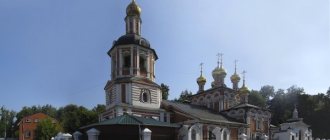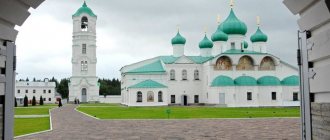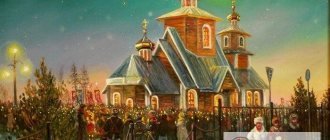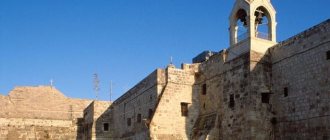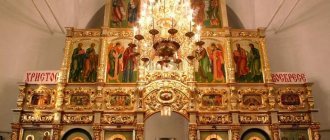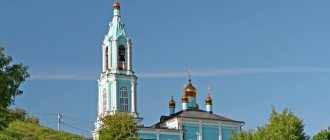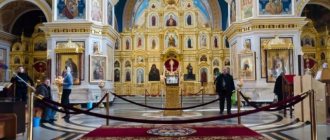History of the temple
A wooden church on the site of the Church of the Nativity on Sands appeared back in 1752. Then a whole settlement of builders and craftsmen was transferred to Sands from the right bank of the Neva. They were subordinate to the Office for the Construction of Houses and Gardens. When planning the area, it was decided to build a temple in the central square. At first it was a small wooden church with a single chapel of All Saints. It was consecrated in 1753.
The wooden church quickly fell into disrepair and became too crowded for its many parishioners. In 1781, a new stone church was laid, which could accommodate, according to some estimates, up to 3 thousand people. The project was developed by the architect P. Egorov. Builders, church parishioners, masons St. Sudakov, completed the rough construction of the building by 1783. At the same time, materials remaining after the dismantling of the palaces were widely used.
The All Saints chapel was consecrated in 1787, and the chapel of the Nativity of the Virgin Mary in 1788. The main altar of the new church was consecrated in 1789. Emperor Paul I, heir Alexander Pavlovich, and Empress Maria Feodorovna were present.
Subsequently, the Church of the Nativity on the Sands underwent many reconstructions and restorations. In 1826, the main aisle was converted into a warm one. Later, the side chapels were moved closer to the altar, decorated with silver reliefs, etc. In 1859, there was a large-scale fire, in which the settlement of the builders of the Chancellery was badly damaged. However, the church survived and was restored. In 1886, another alteration began for the centenary of the temple: the vestibule and sacristy were added, and the main nave was painted.
Craftsmen and builders, parishioners of the church on the Sands were low-income people, and the parish was always involved in charity. There was a charitable brotherhood in the church that ran an orphanage, a school and an almshouse. From 1896 to 1918, a canteen operated to distribute free food to the poor.
In 1933, services stopped in the temple. And in 1934 it was dismantled, despite its status as an architectural monument. The last rector of the Church of the Nativity on the Sands, Archpriest Grigory (Serbarinov), was executed in 1938. There was still a Rozhdestvensky square on the site of the temple.
Shrines
The most revered icon of the Temple on the Sands was the icon of the Nativity of Christ. They turned to her with prayers for the birth, teaching and upbringing of children. Also in 1901, an icon of St. appeared in the church. Guria, Samona and Aviva, found in the earth. She patronized marriage and quickly became highly respected in the area. Before the revolution, the church on Peski kept ancient images, gospels from Elizabethan times in precious frames, church utensils, etc.
TEMPLE BUILDER
The history of St. Petersburg is inextricably linked with the history of the oldest city district of Peski and the Rozhdestvenskaya part of St. Petersburg, named after the Church of the Nativity of Christ on Peski, located until 1934 at the intersection of the current 6th Sovetskaya Street (until 1923 - 6th Rozhdestvenskaya ) and Krasnoborsky Lane (formerly Tserkovny, Rozhdestvensky).
In the second half of the 19th century, in the reference publication “Description of the Streets of St. Petersburg by 1863” by N. Tsylov, the following characteristics of this area are given: “The Rozhdestvenskaya part extends from the Alexander Nevsky Lavra to the Bolshaya Neva and is separated from the Ligovskaya part by a canal and Tavricheskaya Street; inhabited by people of average income and poor people of various classes. The area of this part, consisting of nine (from First to Ninth) Rozhdestvenskaya streets, is known as “Sands”.
The historical district of St. Petersburg, located behind the Ligovsky Canal and known as Peski, was the highest place in the city and was never flooded during floods. The etymology of the name of the area goes back to the sand ridge stretching along Ligovsky Prospekt and running along Suvorovsky Prospekt, to the Neva, and further along Okhta. This ridge was formed by sediments of the prehistoric sea located at this place.
Despite its close proximity to the main thoroughfare of the city - Nevsky Prospekt, Peski remained uninhabited for quite a long time. But by the middle of the 18th century, an urgent need arose to settle ministers, workers and artisans - the builders of St. Petersburg, closer to the place of their labor activity, which, having begun mainly on the Petrograd side, had by that time moved to this side of the Neva, mainly to the Admiralteyskaya and Liteinaya parts. Twice a year - when the Neva opened up and froze, due to the lack of a permanent bridge across the river, workers could not come to work at all for quite a long time. The Office of the Buildings, which was in charge of the palace work and workers (since 1769 - the Office of the Buildings of Her Imperial Majesty's Houses and Gardens), on March 6, 1748, appealed to the Main Police Chief Office with a petition to transfer to its department the empty places lying on the right side of the Ligovsky Canal for their settlement artisans subordinate to the Office. After lengthy correspondence on this matter, on July 10, 1752, permission to this petition followed. Thus, this date - July 10, 1752 according to the old style (July 21, 1752 according to the new style) - can be considered the official date of the founding of the St. Petersburg district of Peski.
In the same 1752, this area was divided into ten lines transverse in relation to the Ligovsky Canal, and two longitudinal along them - Slonovaya Street (from 1900 to the present day Suvorovsky Prospekt) and Degtyarnaya Street, and began to be gradually populated. Places were distributed freely, but exclusively only to artisans and other employees in the department of the Chancellery from buildings. Even after a long time, until the very end of the 18th century, the inhabitants of Peski did not have the right to sell their houses to anyone other than artisans and other employees of this department.
The palace craftsmen who inhabited the Sands were of a wide variety of workshops and activities. Mentions of such areas of their activity as carpentry, carpentry, wheelwork, window work, carving, metalworking, blacksmithing, coppersmithing, soldering, chasing, goldsmithing, watchmaking, mirror-making, varnishing, roofing, painting, tent-making, mosaic-making, chimney-cleaning, etc. have survived to this day. cutting, masonry, plastering and gardening, as well as the following, partly even completely forgotten, professions: font-maker, gardener, sculptor, court servants, such as footmen and chief footmen, grooms, rowers, mushniks, bakers, cooks, confectioners, poultry workers. In addition to workers and artisans, the area is gradually populated by officials of the Office of the Buildings and the Court Office, court servants, officers and soldiers near the regiments stationed, merchants, townspeople and courtyard peasants.
Simultaneously with the beginning of the settlement of Peskov by the palace department in 1752, a wooden parish Nativity Church was built for the residents of the new city part. There were two altars in it: the main altar in the name of the Nativity of Christ, consecrated on March 11, 1753, and the altar in the name of All Saints, which was consecrated in 1766, on June 18. Unfortunately, it is currently impossible to indicate the exact location of the church. Presumably it was located on the current 6th Sovetskaya Street in close proximity to Grechesky Avenue. Based on the name of this church, the entire area adjacent to it was called the Nativity part.
The population of Peski grew rapidly and the small wooden church could no longer accommodate all the parishioners, and therefore on September 18, 1781, a stone church was founded on the main square of the area - the Church of the Nativity of Christ on Peski. The temple was built in the style of strictly classicism according to the design of the architect Pyotr Egorovich Egorov (1731 - 1789), who worked on other projects with such famous architects, creators of the unique appearance of St. Petersburg, as F. Rastrelli, Yu. M. Felten, A. Rinaldi. Together with Felten Egorov P.E. designed and built the “calling card” of St. Petersburg – the Neva fence of the Summer Garden (1772 – 1786). Just like the first Peskovskaya wooden church, built at the expense of the treasury, under the direct supervision of the Office of Buildings, so the stone church was also built at public expense, under the direct supervision of the Office of the Buildings of Her Imperial Majesty Houses and Gardens, which became part of the Gough Quartermaster's Office. At different periods, the work of this department was led by the famous architects D.A. Trezzini, I.E. Starov, Yu.M. Felten.
Inside, the new Church of the Nativity was magnificently decorated with paintings and painted icons made by I.I. Belsky, A.P. Antropov, F.D. Danilov, I.M. Tonkov and A. Shcherbakov, who all served in the Gough Quartermaster Office and for the most part they were parishioners of the Peskov parish.
In 1787, on November 6, the first chapel was consecrated in the name of All Saints. The following year, 1788, on September 8, the chapel in the name of the Nativity of the Virgin Mary was consecrated. Then, exactly ten years later, in 1798, on September 8, the main chapel was consecrated in the name of the Nativity of Christ. Thus, the temple took seventeen years to build. The consecration of the main chapel in the name of the Nativity of Christ was distinguished by great solemnity: “In the second summer of the Reign of the Most Pious Sovereign, Emperor Pavel Petrovich, of All Russia, and His Wife, the Most Pious Empress Maria Feodorovna, and under the heir, the Most Pious Sovereign Tsarevich and Grand Duke Alexander Pavlovich, and under His other high children , this Church of the Nativity of Christ was consecrated by His Eminence Metropolitan Gabriel of Novgorod and St. Petersburg on the 8th day of September 1798.”
In the 19th century, the building of the Church of the Nativity of Christ on the Sands, which had a cross-shaped plan with three domes rising above it: one above the main building of the temple and two above the bell towers, was repeatedly repaired, rebuilt and expanded. The temple could accommodate up to three thousand people. A garden and a small fence were built.
The temple icon of the Nativity of the Blessed Virgin Mary was revered as the patroness of the Sands, to which people from all over Russia came to pray for the gift of children, help during childbirth and in raising children. The locally revered shrine was the icon of the holy martyrs Guria, Samon and Aviv - the patrons of marriage, marriage, and a happy family. Not far from the temple, the miraculous Tikhvin Icon of the Mother of God was miraculously found, which was placed in the Church of the Nativity of Christ, and then in St. Isaac's Cathedral, where it still resides.
From 1856 to 1866, the priest Alexander Vasilyevich Gumilevsky (1830 - 1869) served in the Church of the Nativity of Christ on the Sands, who founded the first charitable society in Russia at the church on April 7, 1863 - the Nativity of Christ Alexander-Joseph Brotherhood, which had as its goal to help the poor arrival A fraternal shelter for the elderly sick and young beggars was opened on Peski, near which, according to the plan of Fr. Alexandra, all parish charity was grouped, and all parish charitable institutions were combined in it: the sick and poor, the elderly and children of the parish, the school and the parish library, the parish choir and assistance to the sick and poor of the parish through the sisters of mercy who served in the orphanage hospital, and through the distribution of cash benefits to the sick and poor in their homes, after checking the degree of their need through these same sisters of mercy. At the same time, through the Brotherhood Shelter, priest Alexander intended to influence the moral correction of the poor and the eradication of beggary itself in the parish, taking adult beggars under his moral supervision and forcing them to work, and, in addition, teaching minors to read and write and handicrafts.
On Sundays and other holidays, the parish shelter hosted dinners for the poor, modeled on ancient church meals.
Since October 22, 1896, a free table for the poor operated daily, which ceased its activities only in 1918. The shelter opened a school for minors, a hospital for women, a women's almshouse for old women, a shelter for poor girls, a handicraft shelter for boys and a handicraft shelter for girls, and a beggar's department. With the opening of the Brotherly Shelter, the previously existing parish institutions of Fr. Alexandra: parish library, parish choir and parish community of sisters of mercy, called “fraternal”.
It is necessary to note the excellent pedagogical idea brilliantly applied by priest Alexander Gumilyovsky in the organization of the Brotherly Orphanage - orphans did not feel as lonely as usually happens in orphanages, having constant attention, love and care of elderly women who arrived in the almshouse of the orphanage. Older women, in turn, felt needed and busy with important work, and not “written off as an expense,” taking part in raising children, giving them and receiving in return love and warmth, the joy of communication. In addition, it is widely known that it is “grandmothers” and “grandchildren” who can achieve true mutual understanding, while the problem of the conflict between “fathers and children” has not lost its relevance to this day. Year after year, the orphanage children were taken to the dacha in the summer, which had a beneficial effect on their health.
The work started by Fr. was so urgently needed for the residents of the Rozhdestvenskaya part. Alexander, that half a century after its founding, in 1913, the brotherhood was active in the following types of assistance to the poor population of the parish: in shelters for young boys and girls living permanently; in a day care center for preschool children; in a dormitory for adult girls studying in trade schools; in a soup kitchen for the visiting poor; in providing one-time and monthly benefits to those in need; in an almshouse for elderly women; in evening classes for children of poor parents, students in primary city schools and attending church and fraternal cafeteria.
Despite the fact that the Church of the Nativity of Christ on the Sands was not only a famous architectural monument, the only major work in the city by the architect P. E. Egorov, a city-forming dominant, but also the center of the spiritual, social, pedagogical and charitable life of our region, at the beginning of 1934 the temple was closed, and in the summer of the same year it was destroyed.
As a result of archaeological research carried out under the control of the Committee for State Control, Use and Protection of Historical and Cultural Monuments of the Government of St. Petersburg, the foundation and lower parts of the walls of the Church of the Nativity on Sands were discovered. The temple is recognized as an object of cultural heritage - a monument of history and culture of the peoples of the Russian Federation, taken under state protection by order of the Committee for State Control, Use and Protection of Historical and Cultural Monuments of the Government of St. Petersburg dated July 19, 2013 as a historical site - a landmark "Church of the Nativity" on the Sands."
It is planned to completely recreate the church according to old plans, photographs, descriptions. The Church of the Nativity of Christ on the Sands will return the city’s lost historical appearance, become a spiritual and educational center, and return a place of worship for centuries to true believers.
Prepared by Varlygo O.Yu.
Source
Architecture
The Church of the Nativity on the Sands was built according to the canons of mature classicism. Representing a cross in plan, it resembled in its spatial design the Trinity Church of the Alexander Nevsky Lavra. An Ionic portico with a pediment adorned the main façade. The entrance, facing west, was crowned on both sides by two bell towers. The voluminous central dome was 13 fathoms (28 m) high.
Recreation
Public discussion on the reconstruction of the Church of the Nativity on the Sands has been going on since 2000. As a result of archaeological research initiated by the Government of St. Petersburg, in 2012 it was possible to discover the foundation and fragments of walls. Currently, the site is taken under protection as a place of interest. Based on the plans and descriptions, a new project was created by the architects from Liteinaya Part 91. More than 300 million rubles were collected. to reconstruct the temple and work began.
Architecture and decoration
The designer and construction manager, architect Andrei Mikhailovich Lebedev, chose the Byzantine design style for the Temple on Kollontai. This gave a resemblance to the Novgorod St. Sophia Cathedral.
The church was built according to the ancient canons of the cross-domed type of construction and there are four altars in it:
- in the name of the Nativity of Christ - the main one;
- in the name of All Saints - a cave temple on the ground floor;
- in the name of the icon of the Mother of God “Quiet my sorrows” - northern (left);
- in the name of St. Great Martyr George the Victorious - southern (right).
The domes decorating the five domes of the temple are also made in the Byzantine style. The icon cases and wooden carved iconostasis were made by the architect's fellow countrymen, Pskovites. The bells were cast in Voronezh, at the bell factory.
The painting of the iconostasis of the cave altar in the name of All Saints was done by Dmitry Evgenievich Selivanov, a master of religious and historical painting.
The main icons are located in the thrones dedicated to them. Some icons are especially valued by parishioners. Flowers are brought to them as a sign of gratitude, and they are considered miraculous. For example, the Icon of the Mother of God “Helper in Childbirth”.
Shrines
A temporary wooden chapel was erected in the name of the most important shrine of the entire complex - the Icon of the Mother of God “Quiet My Sorrows”. It was to her that parishioners prayed while the main construction was underway.
To the right of the main altar there is another significant shrine of the Church of the Bolsheviks - the icon of the Nativity of Christ. It marks one of the patronal feasts and is worshiped during the Christmas liturgy.
There are three icons with relics in the church. For veneration they are exhibited on the days of the saints: St. Joasaph of Belgorod, Hieromartyr John of Riga and St. Anthony of Dym. The relics of John of Riga are also placed under the throne of the main chapel of the temple.
Worship and activities
The Nativity Church awaits parishioners for services every day: from 9:30 for confession, from 10:00 for liturgy. For Evening Services - on weekdays at 18:00. At the same time, the All-Night Vigil takes place on Saturday and Sunday. The singing of akathists is included in the evening services on Wednesday, Sunday and Tuesday.
For godchildren, godparents and those who want to baptize their child, catechesis (instruction in the Orthodox faith) takes place on weekends at 12:00. To do this you need to come to the wooden chapel. The baptism ceremony itself takes place on weekends at one o'clock in the afternoon.
To talk with the priest and ask him questions, you can attend the Pastoral Hour. It takes place on the last Sunday of the month at four o'clock in the lower part of the temple.
Adults and children can learn to understand the Holy Scriptures, study the history of the Church, attend cutting and sewing courses, meet other parishioners and spend time usefully in the Sunday group.
To do this, you should come to the lower part of the temple at the beginning of classes according to the schedule:
- Monday 18:00 - cutting and sewing classes;
- Thursday 18:00 - basics of Orthodox worship;
- Friday - children's groups (17:15 up to 7 years old, 18:00 from 7 years old and older);
- Saturday 16:45 - history of the church;
- Sunday 16:00 - New Testament.
For all parishioners on Saturday and Sunday from one to five o'clock in the evening there is a library where you can get acquainted with theological and patristic literature. The opening of the museum is just being planned, but for now in the corridors of the lower part you can see an exhibition of photographs, drawings and drawings that reflect the life of the temple.
